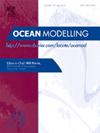北海自由次重力波的重要性:来自野外观测和非结构化SWAN模型的见解
IF 2.9
3区 地球科学
Q2 METEOROLOGY & ATMOSPHERIC SCIENCES
引用次数: 0
摘要
本研究利用最近收集的波浪测量数据和新开发的非结构化SWAN模型,检验了自由次重力波(FIG)在北海的重要性。这些测量包括对北海南部近海(30-40米水深)和近岸(10-20米水深)的次重力波的新观测。这些观测结果是模型优化和验证的基础。在最近的两个风暴期间,模式预测和测量结果非常吻合,包括具有不寻常风向和高风速的强风暴(例如“风暴巴贝特”)。沿着比利时和荷兰海岸的模式调查表明,近岸FIG条件(即能量强度和来源)与风暴特征(即沿岸风型和风暴路径)之间存在很强的依赖性。具体来说,一些风暴已经证明了来自偏远地区(例如,英国和丹麦海岸)的FIG能量的重要贡献。这表明,北海近岸的FIG条件不能仅根据当地的海浪条件来确定,如果忽略非当地的贡献,可能会大大低估。最后,在荷兰海岸近岸地区的模拟和测量结果表明,在风暴条件下,FIG能量可能比束缚次重力波(BIG)能量高一个数量级。这一结果,加上海岸线上自由和强制亚重力能的估计比例,强调了将FIG波作为北海沿岸海岸安全评估的一个组成部分的必要性。本文章由计算机程序翻译,如有差异,请以英文原文为准。
The importance of free infragravity waves in the North Sea: Insights from field observations and unstructured SWAN modelling
This study examines the importance of free infragravity (FIG) waves in the North Sea using a recent collection of wave measurements and a newly developed unstructured SWAN model. The measurements include new observations of infragravity waves at offshore (30–40 m water depth) and nearshore (10–20 m water depth) locations in the southern North Sea. These observations serve as the basis for model optimization and verification. Good agreement is obtained between model predictions and measurements during two recent storm periods, including severe storms with unusual wind directions and high wind speeds (e.g., “Storm Babet”). Model investigation along the coasts of Belgium and the Netherlands demonstrated a strong dependence between nearshore FIG conditions (i.e., energy intensity and sources) and storm characteristics (i.e., alongshore wind pattern and storm track). Specifically, several storms have demonstrated significant contributions of FIG energy originating from remote sources (e.g., the coasts of UK and Denmark). This suggests that nearshore FIG conditions in the North Sea cannot be determined based on the local sea-swell conditions alone and may be significantly underestimated if non-local contributions are ignored. Finally, modelled and measured results at nearshore locations along the Dutch coast revealed that under storm conditions FIG energy can be an order of magnitude higher than energy due to bound infragravity (BIG) waves. This result, augmented with estimated ratios of free and forced infragravity energy at the shoreline, emphasizes the necessity of considering the FIG waves as an integral part of coastal safety assessments along the coasts of the North Sea.
求助全文
通过发布文献求助,成功后即可免费获取论文全文。
去求助
来源期刊

Ocean Modelling
地学-海洋学
CiteScore
5.50
自引率
9.40%
发文量
86
审稿时长
19.6 weeks
期刊介绍:
The main objective of Ocean Modelling is to provide rapid communication between those interested in ocean modelling, whether through direct observation, or through analytical, numerical or laboratory models, and including interactions between physical and biogeochemical or biological phenomena. Because of the intimate links between ocean and atmosphere, involvement of scientists interested in influences of either medium on the other is welcome. The journal has a wide scope and includes ocean-atmosphere interaction in various forms as well as pure ocean results. In addition to primary peer-reviewed papers, the journal provides review papers, preliminary communications, and discussions.
 求助内容:
求助内容: 应助结果提醒方式:
应助结果提醒方式:


